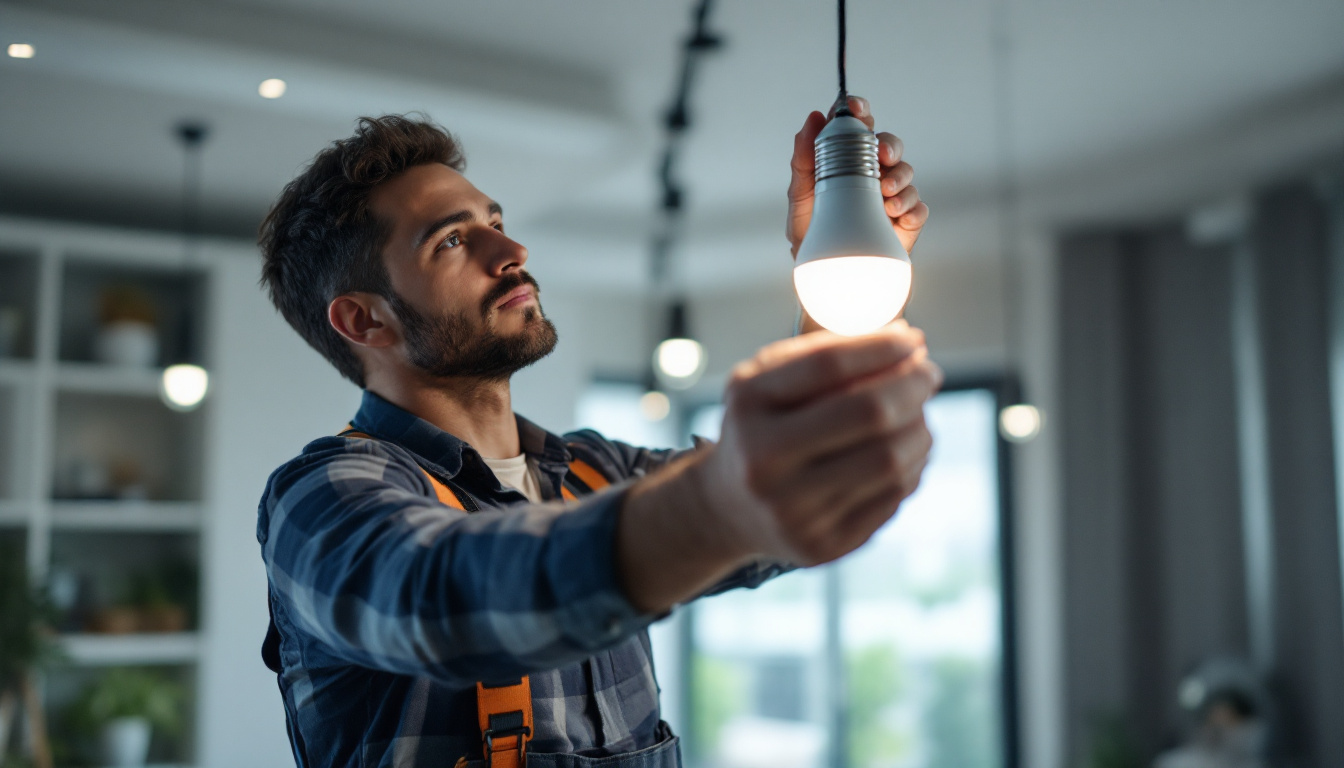
In recent years, ultraviolet (UV) light has gained significant attention as a powerful tool for sterilization. Its ability to eliminate pathogens makes it a valuable asset in various industries, from healthcare to food processing. However, when integrating UV lighting into projects, contractors must navigate a complex landscape of technical specifications, safety regulations, and installation challenges. This article aims to guide lighting contractors through the essential considerations to avoid costly mistakes in UV light sterilization projects.
Before diving into the intricacies of UV light sterilization, it is crucial to understand the fundamentals of UV light itself. UV light is a form of electromagnetic radiation that falls between visible light and X-rays on the spectrum. It is divided into three categories: UVA, UVB, and UVC, with UVC being the most effective for sterilization purposes.
UVA light, which has the longest wavelength, is primarily associated with skin aging and tanning. UVB light, while responsible for sunburns, has limited sterilization capabilities. UVC light, on the other hand, is highly effective at destroying bacteria, viruses, and other microorganisms. This makes UVC the preferred choice for sterilization applications. The effectiveness of UVC light in disrupting the DNA of pathogens has led to its widespread adoption in various industries, making it a powerful tool in the fight against infectious diseases.
UV light is utilized in various settings, including hospitals, laboratories, and food production facilities. In healthcare, UVC light is employed to disinfect surfaces and air in operating rooms and patient rooms. In the food industry, it is used to sterilize equipment and packaging materials, ensuring that products are safe for consumption. Understanding these applications helps contractors identify potential markets for UV lighting solutions. Beyond these environments, UVC technology is increasingly being integrated into water treatment systems, where it effectively eliminates harmful microorganisms from drinking water, making it a vital component for public health. Furthermore, as the demand for cleaner and safer environments grows, UV light is also being explored for use in residential settings, such as in HVAC systems to purify indoor air quality.
Despite its advantages, many contractors encounter pitfalls when implementing UV light sterilization systems. Recognizing these common mistakes can save time, resources, and enhance the effectiveness of the project.
One of the most critical factors in UV sterilization is ensuring adequate exposure time and intensity. Contractors often underestimate the required dose of UV light necessary to achieve effective sterilization. Each microorganism has a specific UV dose needed for inactivation, and failing to account for this can lead to insufficient disinfection.
To avoid this mistake, it is essential to conduct thorough research on the pathogens of concern and their corresponding UV dose requirements. Additionally, utilizing UV dose calculators can assist in determining the appropriate intensity and exposure time for the specific application. Furthermore, it is beneficial to consider the environmental factors that can influence UV effectiveness, such as the presence of dust, water turbidity, or surface materials that may absorb UV light. Regular monitoring and adjustments based on real-time data can also enhance the system’s performance, ensuring that the UV sterilization remains effective over time.
Safety should always be a top priority when working with UV light. Contractors often overlook the necessary safety protocols, which can lead to severe consequences, including health risks to workers and end-users. UVC light can cause skin burns and eye injuries if proper protective measures are not implemented.
To mitigate these risks, contractors must familiarize themselves with local regulations and guidelines regarding UV light usage. This includes installing safety interlocks, using protective barriers, and providing adequate training for personnel involved in the project. Additionally, it is crucial to implement a comprehensive safety plan that includes regular safety audits and the use of personal protective equipment (PPE) such as UV-blocking goggles and protective clothing. Engaging with safety experts during the planning phase can also provide valuable insights into best practices and help create a culture of safety within the project team, ensuring that everyone is aware of the potential hazards and the measures in place to protect them.
The choice of UV light source can significantly impact the effectiveness and efficiency of a sterilization project. Contractors must consider various factors when selecting the appropriate UV light source for their applications.
There are several types of UV light sources available, including mercury vapor lamps, low-pressure mercury lamps, and LED UV lights. Each type has its advantages and disadvantages, depending on the specific application.
Mercury vapor lamps are known for their high intensity and effectiveness in large spaces, but they have a longer warm-up time and require careful handling due to the presence of mercury. Low-pressure mercury lamps are more energy-efficient and have a longer lifespan, making them suitable for continuous use. LED UV lights, while still emerging in the market, offer the advantage of instant on/off capabilities and lower energy consumption. Furthermore, LED technology allows for a more compact design, making it easier to integrate into various settings, from small laboratories to expansive industrial facilities.
In addition to these common types, there are also specialized UV light sources designed for specific applications, such as germicidal lamps that emit UV-C light, which is particularly effective at destroying bacteria and viruses. Understanding the specific needs of the environment, such as the type of pathogens present and the area size, can guide contractors in selecting the most effective UV light source for their project.
energy efficiency is a crucial consideration in any lighting project. Contractors should evaluate the energy consumption of different UV light sources and consider the long-term operational costs. While initial costs may be higher for certain types of UV lights, their energy efficiency can lead to significant savings over time.
Additionally, implementing smart controls and automation can further enhance energy efficiency by optimizing the operation of UV lights based on real-time conditions. For instance, integrating sensors that detect occupancy or ambient light levels can ensure that UV lights are only activated when necessary, minimizing energy waste. Moreover, advancements in technology have led to the development of UV light systems that can be remotely monitored and controlled, allowing for more precise management of energy usage and maintenance schedules. This not only contributes to lower operational costs but also extends the lifespan of the equipment, making it a wise investment for contractors looking to maximize their return on investment.
A well-designed UV lighting system is essential for maximizing sterilization effectiveness. Contractors must consider various design elements to ensure optimal performance.
The placement of UV lights is critical for achieving uniform coverage and effective sterilization. Contractors should conduct a thorough assessment of the space to determine the best locations for UV light installation. Factors such as room size, shape, and potential obstructions should be taken into account.
In some cases, it may be necessary to use multiple UV light sources to achieve adequate coverage. Additionally, considering the angle and orientation of the lights can help ensure that all surfaces receive sufficient UV exposure.
Contractors often face challenges when integrating UV lighting into existing systems. Whether it’s retrofitting an older facility or incorporating UV lights into a new design, careful planning is essential. Compatibility with existing electrical systems, HVAC units, and safety measures must be evaluated to ensure seamless integration.
Collaboration with other contractors and stakeholders can facilitate a smoother integration process. Open communication helps address potential challenges early on and ensures that all parties are aligned on project goals.
Once the UV lighting system is installed, it is crucial to conduct thorough testing and validation to ensure its effectiveness. This step is often overlooked, leading to potential failures in sterilization.
Performance testing involves measuring the UV intensity and ensuring that it meets the specified requirements. Contractors should use calibrated UV meters to assess the output of the UV lights and verify that they are operating within the desired parameters.
Additionally, testing should include monitoring the system’s performance over time. Regular maintenance checks can help identify any issues that may arise and ensure that the UV lights continue to operate effectively.
Validation protocols are essential for confirming that the UV lighting system achieves the intended sterilization results. Contractors should establish a comprehensive validation plan that includes microbiological testing to assess the system’s effectiveness against specific pathogens.
Documenting the validation process is crucial for compliance with industry standards and regulations. This documentation can also serve as a valuable resource for future projects and audits.
Education plays a vital role in the successful implementation of UV lighting systems. Contractors must ensure that clients and end-users understand the benefits and limitations of UV sterilization.
comprehensive training programs should be developed to educate staff on the proper use and maintenance of UV lighting systems. This includes understanding safety protocols, operational procedures, and troubleshooting techniques.
Training sessions can be conducted through workshops, online courses, or hands-on demonstrations. Ensuring that all personnel are well-informed will enhance the overall effectiveness of the UV sterilization system.
While UV light is a powerful sterilization tool, it is essential to communicate its limitations to clients and end-users. UV sterilization is most effective when used in conjunction with other cleaning and disinfection methods. Educating clients about the importance of a multi-faceted approach to hygiene can lead to better overall results.
Integrating UV light for sterilization purposes presents unique challenges and opportunities for lighting contractors. By understanding the basics of UV light, recognizing common pitfalls, choosing the right light sources, designing effective systems, conducting thorough testing, and educating clients, contractors can navigate these projects with confidence.
Ultimately, a well-executed UV lighting project not only enhances safety and hygiene but also positions contractors as leaders in the evolving landscape of lighting solutions. By avoiding costly mistakes and embracing best practices, contractors can ensure successful outcomes for their clients and contribute to a healthier environment.
Ready to elevate your lighting projects with the power of UV sterilization? At LumenWholesale, we provide you with the spec-grade UV lighting solutions you need to ensure your projects are a shining success. Our commitment to quality and affordability means you can access the best lighting products at wholesale prices, without the hassle of dealing with middlemen. Plus, with free shipping on bulk orders, you can stock up on all the UV lighting essentials while keeping your costs down. Don’t compromise on quality or value—choose LumenWholesale for lighting that meets the highest industry standards. Wholesale Lighting at the Best Value is just a click away.

Illuminate your outdoor spaces with ease using solar driveway lanterns.

Discover effective strategies for training your team in the installation and maintenance of lighted electrical switches.

Discover the pros and cons of semi flush mount lighting compared to other popular options.

Discover expert insights and practical advice from lighting contractors on maximizing the efficiency and lifespan of Flourcenet bulbs.